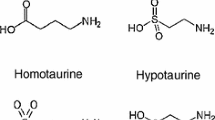Abstract
Activation of protein-activated receptor (PAR-1) by thrombin potentiates the hyposmotic efflux of 3H-d-aspartate and 3H-taurine from cultured cerebellar astrocytes. This effect is mediated by a thrombin-elicited increase in cytosolic Ca2+ levels [Ca2+]i and the activation of phosphoinositide-3-kinase (PI3K). These signalling pathways operate independently showing additive effects if prevented simultaneously. The contribution of the Ca2+-mediated pathway to thrombin-increased d-aspartate or taurine efflux, evaluated by the inhibitory effect of preventing [Ca2+]i rise, was higher for d-aspartate (64% efflux decrease) than for taurine (40% decrease). The PI3K blocker decreased 48% and 36% d-aspartate and taurine efflux, respectively. Hyposmolarity increases phosphorylation of EGFR and c-src, but thrombin did not enhance this effect. Blockade of EGFR/src phosphorylation marginally reduced (11–14%) the hyposmolarity plus thrombin efflux of d-aspartate; taurine efflux was more sensitive to these blockers (18–26%). Since thrombin has no effect increasing EGFR/src phosphorylation in astrocytes, the contribution of this transactivation pathway may represent the inhibition of the hyposmotic efflux solely.







Similar content being viewed by others

References
Sterns RH, Silver SM (2006) Brain volume regulation in response to hypo-osmolality and its correction. Am J Med 119:S12–S16
Unterberg AW, Stover J, Kress B et al (2004) Edema and brain trauma. Neuroscience 129:1021–1029
Mongin AA (2007) Disruption of ionic and cell volume homeostasis in cerebral ischemia: the perfect storm. Pathophysiology 14:83–93
Norenberg MD (1993) Astroglial dysfunction in hepatic encephalopathy. Metab Brain Dis 13:319–335
Nagelhus EA, Lehmann A, Ottersen OP (1993) Neuronal-glial exchange of taurine during hypo-osmotic stress: a combined immunocytochemical and biochemical analysis in rat cerebellar cortex. Neuroscience 54:615–631
Walz W (2000) Role of astrocytes in the clearance of excess extracellular potassium. Neurochem Int 36:291–300
Leis JA, Bekar LK, Walz W (2005) Potassium homeostasis in the ischemic brain. Glia 50:407–416
Hoffmann EK, Pedersen SF (2006) Sensors and signal transduction pathways in vertebrate cell volume regulation. Contrib Nephrol 152:54–104
Wehner F, Olsen H, Tinel H et al (2003) Cell volume regulation: osmolytes, osmolyte transport, and signal transduction. Rev Physiol Biochem Pharmacol 148:1–80
Pasantes-Morales H, Lezama RA, Ramos-Mandujano G et al (2006) Mechanisms of cell volume regulation in hypo-osmolality. Am J Med 119:S4–S11
Tuz K, Peña-Segura C, Franco R et al (2004) Depolarization, exocytosis and amino acid release evoked by hyposmolarity from cortical synaptosomes. Eur J Neurosci 19:916–924
Pasantes-Morales H, Morales Mulia S (2000) Influence of calcium on regulatory volume decrease: role of potassium channels. Nephron 86:414–427
Stutzin A, Hoffmann EK (2006) Swelling-activated ion channels: functional regulation in cell-swelling, proliferation and apoptosis. Acta Physiol 187:27–42
Niemeyer MI, Stutzin A, Sepúlveda FV (2002) A voltage-independent K+ conductance activated by cell swelling in Ehrlich cells is modulated by a G-protein-mediated process. Biochim Biophys Acta 1562:1–5
Cardin V, Lezama R, Torres-Márquez ME et al (2003) Potentiation of the osmosensitive taurine release and cell volume regulation b cytosolic Ca2+ rise in cultured cerebellar astrocytes. Glia 44:119–128
Vázquez-Juárez E, Ramos-Mandujano G, Hernández-Benítez R et al (2007) On the role of G-protein coupled receptors in cell volume regulation. Cell Biochem Physiol In press
Ramos-Mandujano G, Vázquez-Juárez E, Hernández-Benítez R et al (2007) Thrombin potently enhances swelling-sensitive glutamate efflux from cultured astrocytes. Glia 55:917–925
Mongin AA, Kimelberg HK (2005) ATP regulates anion channel-mediated organic osmolyte release from cultured rat astrocytes via multiple Ca2+-sensitive mechanisms. Am J Physiol Cell Phisiol 288:C204–C213
Heacock AM, Kerley D, Gurda GT et al (2004) Potentiation of the osmosensitive release of taurine and D-Aspartate from SH-SY5Y neuroblastoma cells after activation of M3 muscarinic cholinergic receptors. J Pharm Exp Ther 311:1097–1104
Loveday D, Heacock AM, Fisher SK (2003) Activation of muscarinic cholinergic receptors enhances the volume-sensitive efflux of myo-inositol from SH-SY5Y neuroblastoma cells. J Neurochem 87:476–486
Franco R, Lezama R, Ordaz B (2004) Epidermal growth factor receptor is activated by hyposmolarity and is an early signal modulating osmolyte efflux pathways in Swiss 3T3 fibroblasts. Pflugers Arch-Eur J Physiol 447:830–839
Kippenberger S, Loitsch S, Guschel M et al (2005) Hypotonic stress induces E-cadherin expression in cultured human keratinocytes. FEBS Lett 579:207–214
Lezama R, Ortega A, Ordaz B et al (2005) Hyposmolarity-induced ErbB4 phosphorylation and its influence on the non-receptor tyrosine kinase network response in cultured cerebellar granule neurons. J Neurochem 93:1189–1198
Daub H, Wallasch C, Lankenau A et al (1997) Signal characteristics of G protein-transactivated EGF receptor. EMBO J 16:7032–7044
Luttrell LM, Daaka Y, Lefkowitz RJ (1999) Regulation of tyrosine kinase cascades by G-protein-coupled receptors. Curr Opin Cell Biol 11:177–183
Luttrell DK, Luttrell LM (2004) Not so strange bedfellows: G-protein-coupled receptors and src family kinases. Oncogene 23:7969–7978
Vázquez-Juárez E, Lezama RA, Ramos-Mandujano G et al (2007) Thrombin potentiates hyposmotic taurine efflux, ICl− swell and RVD in Swiss 3T3 fibroblasts by a src-dependent EGFR transactivation. Pflugers Arch-Eur J Physiol 455:859–872
Cheema TA, Ward CE, Fisher SK (2005) Subnanomolar concentrations of thrombin enhance the volume-sensitive efflux of taurine from human 1321N1 astrocytoma cells. J Pharm Exp Ther 315:755–763
Cheema TA, Pettigrew VA, Fisher SK (2007) Receptor regulation of the volume-sensitive efflux of taurine and iodide from human SH-SY5Y neuroblastoma cells: differential requirements for Ca(2+) and protein kinase C. J Pharmacol Exp Ther 320:1068–1077
Liu B, Neufeld AH (2007) Activation of epidermal growth factor receptors in astrocytes: from development to neural injury. J Neurosci Res 85:3523–3529
Acknowledgements
The authors acknowledge the valuable technical assistance of Claudia Peña Segura and Gerardo Ramos Mandujano. This work was supported by grants No. 46465 from CONACYT, México and IN209507 from DGAPA, UNAM.
Author information
Authors and Affiliations
Corresponding author
Additional information
Special issue article in honor of Dr. Ricardo Tapia.
Rights and permissions
About this article
Cite this article
Cruz-Rangel, S., Hernández-Benítez, R., Vázquez-Juárez, E. et al. Potentiation by Thrombin of Hyposmotic Glutamate and Taurine Efflux from Cultured Astrocytes: Signalling Chains. Neurochem Res 33, 1518–1524 (2008). https://doi.org/10.1007/s11064-008-9632-x
Received:
Accepted:
Published:
Issue Date:
DOI: https://doi.org/10.1007/s11064-008-9632-x



